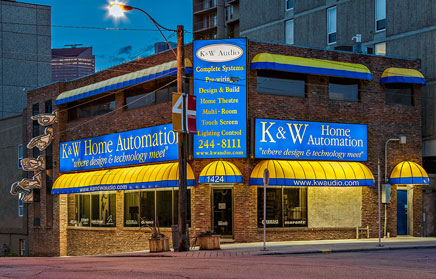TIP #15:
Most stereo systems have the ability to run two sets of speakers, with the idea of using the second set in a different room from the main set. This is all very well, but what if you want to change the source you are listening to, or change the volume from that other room? The generic term for expanding accessibility to the main system from other rooms is “multi-room audio”. Multi-room audio is a vast and convoluted world. We do not have enough room here to explore fully all the permutations, however we will try to cover all the bases. If you wish to have the ability to change volume and source from one extra room, this can accomplished easily with a minimum of fuss. However, if you wish to expand on the idea, i.e. having access to the system from many rooms with as much system control as you would have at the system itself, an experienced system consultant is a must. Your amplifier/receiver is the heart of the multi room system. If the system is to be remote from other locations, obviously the amp must be remote. If running multiple speakers is a priority, your amplifier must have sufficient power to handle the load and, of course, your speakers will need to have cables run to them from the main system. To control volume from another room will require transmitting the remote signal back to the main system. The simplest and least expensive method is the use of a slick system called the POWERMID. It consists of two gloss black 6 inch high pyramids ($100 for the pair). The system works by having one pyramid in the auxiliary room and one opposite the main system. When the amplifier’s remote control is pointed at the POWERMID in the second room, the signal is converted from infrared to a radio signal, and is then broadcast to the POWERMID in the main system room. The signal is then converted back to infrared, thereby controlling the amplifier with the same effect as if the remote control was in the room. This is especially convenient, since aside from speaker cables, wires are not needed. If remote control from additional rooms is required (assuming the amp can handle it), add one more POWERMID ($50) per room and away you go. The main drawback to a simple system like this is that all speakers connected to the amp come on when one room is turned on, and the volume control changes in all rooms simultaneously. With the installation of a volume control in the speaker lines in the “add on” rooms ($60 – $200), independent volume control is possible – but beyond two auxiliary rooms the system becomes cumbersome, and the cost approaches that of the next level of sophistication. The next level usually begins at the three room/zone level, and this is where professional help becomes very useful. Having all the rooms come on when you access from one room can be a pain, so if you wish to access the main system from several different rooms, its YAMAHA to the rescue! YAMAHA manufactures multi-room components for many companies. The MCX-10 multi room controller is available with a variety of names on the front, however (strangely enough!) YAMAHA is the least expensive. The MCX-10 is about the same size as most tuners and is incorporated with the main system. It will work with any brand of remote control and communicates with each remote component in the system by means of a very small led placed over the remote eye on each piece ($15 ea.) It has the capability to process “remote information” independently, from five separate zones, in addition to the main room. Several of these units can be “daisy chained” for larger applications, costing around $450. An eye is required in each room (around $100 ea) and requires a 4 conductor, telephone type cable between the eye and controller. When finished you will have one extra component in your system, an elegant looking eye in the wall of each zone, plus speakers of course. Each room will now operate independently, without any other room coming on, and all rooms can be controlled (master on/off) from the main system too. The next level of sophistication available is independent source and volume capability. This is the ability to listen to the radio quietly upstairs, watch a loud movie on the Home Theatre downstairs and listen to a CD in the kitchen, all at the same time. This is an amplifier function, which the YAMAHA system accomplishes with the addition of additional amplifiers in the main system, one to run each zone independently. This is the ultimate level of sophistication and definitely requires a helpful body. No matter what your required level of sophistication around the house, hi-fi can enhance your lifestyle as few other additions can. With a good audio/video consultant, all you really need to know is where in the house you wish to have sound and/or picture and he (we) can do the rest!


